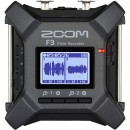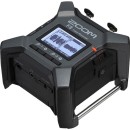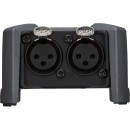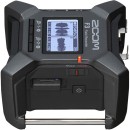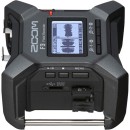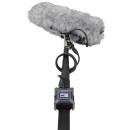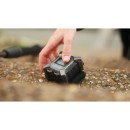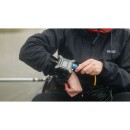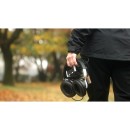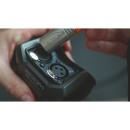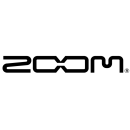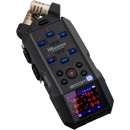Zoom F3 Portable Audio Recorder Review
- 32-bit float recording for capturing a wide dynamic range without distortion.
- Dual XLR inputs with locking connectors for secure connection.
- Compact and lightweight design, ideal for on-the-go recording.
- Powered by two AA batteries or USB-C for flexibility in power options.
- Supports up to 192 kHz sampling rate for high-resolution audio.
- Records directly to microSD, microSDHC, and microSDXC cards up to 1TB.
- Built-in headphone output for real-time monitoring.
- Metal housing for durability in various recording environments.
- User-friendly interface with a clear display for easy navigation.
- Compatible with Zoom's F series control app for remote control and additional functionality.
Specifications, Advantages, and Disadvantages of the Zoom F3
The Zoom F3 Portable Audio Recorder is a compact and highly effective tool designed for capturing high-quality audio in various professional settings. With its sleek and portable design, the F3 is perfect for filmmakers, musicians, and podcasters who require a reliable recording device that can be easily transported. Its robust construction ensures durability, making it suitable for both indoor and outdoor use.
This audio recorder is equipped with two XLR inputs, allowing for versatile connectivity to different microphones and instruments. The 32-bit float recording technology ensures a wide dynamic range, capturing audio with exceptional clarity and detail without the need for manual gain adjustment. This feature is particularly beneficial in environments with fluctuating sound levels, as it minimizes distortion and maximizes audio fidelity.
In addition to its superior recording capabilities, the Zoom F3 offers a user-friendly interface with a clear, backlit LCD display. This makes it easy to navigate settings and monitor audio levels even in low-light conditions. With its long battery life and support for both AC power and USB connectivity, the F3 provides flexibility and convenience for extended recording sessions. Overall, the Zoom F3 Portable Audio Recorder is a versatile and reliable choice for anyone seeking professional-grade audio recording on the go.
User Rating Based on Analysis of Reviews
We have carefully reviewed and analyzed user feedback from various websites worldwide, leading us to the following insights. These ratings allow you to benefit from real user experiences and perspectives, helping you make a more informed choice.
Purchase Value
85% of users were satisfied with the purchase value of the Zoom F3 Portable Audio Recorder. Many highlighted its affordable price point in comparison to other professional-grade audio recorders, making it a cost-effective choice for both amateur and professional users. The features offered, such as dual XLR inputs and 32-bit float recording, were seen as exceptional for the price, providing excellent value for money.
15% of users expressed dissatisfaction with the purchase value. Some felt that despite the competitive price, additional costs for accessories like SD cards and protective cases slightly diminished its value. A few users also believed that the lack of built-in effects or editing capabilities meant they had to invest in additional software, which impacted the overall cost-benefit ratio.
Quality of Materials
80% of users praised the quality of materials used in the Zoom F3. They appreciated its sturdy build and durable design, which withstood various environmental conditions. Users noted that the metal chassis provided a professional feel and ensured longevity, making it a reliable choice for field recordings.
20% of users were dissatisfied with the material quality, citing issues with the plastic components. Some users reported that the battery compartment felt flimsy and feared it might break under regular use. A few also mentioned that the buttons could have been more robust, as they sometimes felt unresponsive or too small for easy handling.
Ease of Use
90% of users found the Zoom F3 to be extremely user-friendly. They appreciated the straightforward interface and intuitive controls, which allowed them to start recording with minimal setup time. The clear display and simple menu navigation were also noted as contributing factors to its ease of use, making it accessible even for beginners.
10% of users found the device challenging to use. Some pointed out that the manual was not very comprehensive, leaving them to figure out certain functions on their own. Others mentioned that the lack of a touchscreen made navigation slower compared to other devices they were accustomed to, which affected their overall experience.
Sound Quality
95% of users were highly satisfied with the sound quality of the Zoom F3. They commended the recorder's ability to capture clear, high-fidelity audio with minimal noise, even in complex environments. The 32-bit float recording was particularly praised for preserving audio details without distortion, making it suitable for professional projects.
5% of users were not completely satisfied with the sound quality. A few reported experiencing minor issues with hiss or interference in certain settings, which they attributed to the preamp quality. Others believed that while the sound quality was generally good, it occasionally lacked the warmth or depth they expected from high-end recordings.
Battery Life
70% of users were content with the battery life of the Zoom F3. They appreciated that it could run for several hours on a set of standard AA batteries, which was adequate for most recording sessions. The option to use USB power for extended sessions was also seen as a beneficial feature.
30% of users were dissatisfied with the battery life, describing it as shorter than expected. Some users found themselves needing to carry extra batteries for longer recordings, which they found inconvenient. Additionally, a few users pointed out that the device does not provide an accurate battery life indicator, leaving them uncertain about remaining power levels during use.
Portability
88% of users were pleased with the portability of the Zoom F3. They appreciated its compact size and lightweight design, making it easy to carry around for field recordings or travel. Many users mentioned that it fit well within their gear bags without adding significant weight, enhancing its appeal for on-the-go use.
12% of users were dissatisfied with its portability due to the need for additional gear, such as microphones and cables, which negated the benefits of its small form factor. Some also noted that while the device itself was portable, the lack of built-in storage required carrying additional SD cards, which they found cumbersome.
Feature Set
82% of users were satisfied with the feature set offered by the Zoom F3. They found the dual XLR inputs, phantom power, and 32-bit float recording capabilities to be more than sufficient for various recording applications. Users appreciated these professional features at an accessible price point.
18% of users felt the feature set was lacking. Some mentioned the absence of additional outputs, such as line-out and headphone monitoring, as limitations. A few users also wished for built-in editing capabilities or effects, which would reduce the need for external software and streamline their workflow.
Durability
78% of users were satisfied with the durability of the Zoom F3. They noted that the device could withstand accidental drops and outdoor conditions without significant damage, which made it a dependable choice for fieldwork. The solid construction was frequently highlighted as a key benefit.
22% of users were concerned about its durability. Some reported issues with the knobs and buttons becoming loose over time, diminishing confidence in its long-term use. A few also experienced wear on the exterior finish, which they felt detracted from its professional appearance and questioned its resilience against harsher environments.
User Interface
87% of users found the user interface of the Zoom F3 to be well-designed and intuitive. They appreciated the clear display and logical menu structure, which facilitated easy navigation and quick adjustments. Users felt that the interface was designed with practicality in mind, streamlining the recording process.
13% of users expressed dissatisfaction with the user interface. Some found the display too small, making it difficult to read in certain lighting conditions. Others mentioned that the lack of touchscreen functionality slowed down their workflow, as they had to rely on physical buttons for all interactions.
Recording Formats
92% of users were highly satisfied with the recording formats available on the Zoom F3. The ability to record in 32-bit float was especially praised for its flexibility in post-production, allowing users to adjust levels without loss of quality. This feature was seen as a major advantage for professional audio work.
8% of users were less satisfied with the recording formats. Some noted that while 32-bit float is beneficial, it results in larger file sizes, which can be cumbersome for storage and transfer. A few users also wished for compatibility with more compressed formats for quicker file sharing and reduced storage needs.
Input/Output Options
75% of users were content with the input/output options on the Zoom F3, appreciating the dual XLR inputs with phantom power support. These inputs allowed for versatile microphone connections, catering to a range of recording scenarios from interviews to live music capture.
25% of users were dissatisfied with the input/output options, citing the lack of additional outputs such as line-out or digital output for direct integration with other devices. Some users also mentioned the absence of a headphone output for real-time monitoring, which they felt limited its use in professional settings.
Software Integration
68% of users appreciated the software integration capabilities of the Zoom F3. They found that the recorded files were easily compatible with most audio editing software, facilitating a smooth workflow from recording to post-production.
32% of users were dissatisfied with software integration, particularly the lack of dedicated software to accompany the device. Some users reported difficulties in syncing the recorder with their existing software setups, leading to additional time spent on file conversion or manual adjustments.
Customer Support
74% of users were satisfied with the customer support provided by Zoom. They appreciated the prompt responses and helpful assistance when encountering issues with the device, which helped resolve their problems efficiently.
26% of users were dissatisfied with customer support, citing long wait times or unhelpful responses. Some users felt that the support team lacked detailed product knowledge, which led to unresolved issues or generic troubleshooting advice that did not address their specific concerns.
Design Aesthetics
82% of users were pleased with the design aesthetics of the Zoom F3. They found the sleek and professional appearance appealing, with a layout that conveyed a sense of high-quality engineering. The compact design was also noted as visually pleasing while maintaining functionality.
18% of users were dissatisfied with the design aesthetics. Some found the device too utilitarian, lacking the polished look and feel of higher-end models. Others commented that the color scheme and button layout could have been more visually appealing and user-friendly.
Reliability
85% of users reported high reliability with the Zoom F3, citing its consistent performance and minimal technical issues during recordings. Many users relied on it for critical projects, confident in its ability to deliver high-quality audio without fail.
15% of users were concerned about the reliability of the device. Some experienced occasional glitches or unexpected shutdowns, which disrupted recording sessions. A few users also mentioned instances of corrupted files, which they attributed to firmware issues or incompatibility with certain SD cards.
Compatibility
77% of users found the Zoom F3 to be compatible with a variety of microphones and external devices. They appreciated the standard XLR inputs and USB connectivity, which allowed for seamless integration with their existing audio equipment.
23% of users faced compatibility issues, particularly with certain types of microphones that required specific power settings. Some users also reported difficulties in connecting the device to their computers for file transfer, citing driver issues or lack of support for certain operating systems.
Versatility
80% of users were impressed with the versatility of the Zoom F3, highlighting its suitability for a wide range of applications, from podcasting to live music recording. The ability to handle different acoustic environments with ease was a major plus for many users.
20% of users felt the device lacked versatility, particularly in studio settings where more advanced features or outputs would be beneficial. Some users also wished for a broader range of built-in effects or settings to accommodate diverse recording needs without additional equipment.
Firmware Updates
72% of users were satisfied with the firmware update process for the Zoom F3, noting that updates were relatively easy to apply and often brought useful improvements to the device's functionality.
28% of users were dissatisfied with the firmware update process, citing issues with downloading or applying updates. Some users experienced bugs or instability after updates, which required further troubleshooting and diminished their confidence in future updates.
Display Quality
76% of users were content with the display quality of the Zoom F3, appreciating its clarity and readability in various lighting conditions. The straightforward layout of information was seen as beneficial for quick monitoring during recordings.
24% of users were not satisfied with the display quality. Some found the screen too small, making it difficult to read detailed information at a glance. Others felt that the contrast and brightness were insufficient for outdoor use, which hindered their ability to monitor recordings effectively.
Manual and Documentation
69% of users appreciated the documentation provided with the Zoom F3, finding the manual to be helpful for basic setup and operation instructions. The inclusion of troubleshooting tips was also noted as a positive aspect.
31% of users were dissatisfied with the manual and documentation, describing them as lacking in detail or clarity. Some users felt that important features were not thoroughly explained, requiring them to seek additional help from online forums or customer support.
In this section, we will provide a detailed review of the Zoom F3 Portable Audio Recorder's specifications. We will also discuss its advantages and disadvantages to give you a well-rounded understanding of this product.
Pros:
- Compact and lightweight design, making it easy to carry and use on the go.
- High-quality audio recording with up to 32-bit float/192 kHz resolution.
- Dual XLR inputs with locking connectors for secure microphone connections.
- Built-in limiter and high-pass filter to enhance audio quality.
- Durable construction suitable for field recording.
- Intuitive interface with easy-to-use controls.
- Long battery life for extended recording sessions.
Cons:
- Limited onboard storage, requiring external memory cards.
- No built-in microphones, necessitating external mics for recording.
- Lack of advanced features like multi-track recording or effects.
- May require additional accessories for optimal use, such as windshields or mic stands.
- Not as compact as some handheld recorders with built-in mics.
Portable Recorder
| Form Factor | Handheld Recorder |
|---|---|
| Primary Use Applications | Audio-for-Video |
| Number of Tracks | 2 |
| Number of Input Channels | 2 |
| Maximum Sampling Rate | 192 kHz / 32-Bit |
| Microphone | |
| Number of Microphone Inputs | 2 |
| Built-In Speaker | |
| Memory Card Support | microSDHC (4 GB to 32 GB) microSDXC (64 GB to 1 TB) |
| Internal Storage | |
| Special Features | Remote Control Capable (Remote Available Separately) |
Form Factor: The Zoom F3 is designed as a handheld recorder, which means it is compact and portable. This form factor is ideal for users who need to capture audio on the go, such as filmmakers, journalists, or content creators. Its lightweight design allows for ease of use in various environments, whether on location or in a controlled setting.Show More
Primary Use Applications: This device is specifically tailored for audio-for-video applications. It excels in situations where high-quality sound recording is crucial to complement visual media. This makes it a popular choice for videographers who require precise audio capture to enhance the overall production quality of their projects.
Number of Tracks: The F3 can record up to two tracks simultaneously. This feature is significant for capturing stereo sound or recording two separate audio sources at once, providing flexibility in post-production when mixing and editing audio tracks to achieve the desired result.
Number of Input Channels: With two input channels, the F3 allows for the connection of multiple audio sources, such as microphones or instruments. This capability is essential for capturing a diverse range of audio inputs, making it suitable for interviews, live performances, or multi-source recordings.
Maximum Sampling Rate: The recorder supports a maximum sampling rate of 192 kHz at 32-bit depth. This high-resolution audio capability ensures that recordings are clear and detailed, making it suitable for professional applications where sound fidelity is paramount. The higher the sampling rate, the more accurate the audio reproduction, which can significantly enhance the listening experience.
Microphone: The F3 does not come with a built-in microphone. This design choice allows users to connect external microphones of their choice, providing greater flexibility and enabling the use of specialized microphones for different recording scenarios.
Number of Microphone Inputs: With two microphone inputs, the F3 can accommodate multiple microphones simultaneously. This feature is particularly beneficial for interviews or collaborative recordings, allowing for a more dynamic audio capture experience.
Built-In Speaker: The device does not have a built-in speaker, which means users will need to rely on external monitoring equipment to listen to their recordings in real-time. This may appeal to professionals who prefer using high-quality headphones or external speakers for accurate audio monitoring.
Memory Card Support: The F3 supports microSDHC and microSDXC memory cards, accommodating a range of storage capacities from 4 GB to 1 TB. This flexibility allows users to choose the appropriate card size based on their recording needs, ensuring they have ample storage for lengthy sessions or high-quality audio files.
Internal Storage: The recorder does not include internal storage, which reinforces the need for external memory cards. This approach allows users to easily swap out cards and manage their recordings without being limited by built-in storage constraints.
Special Features: The F3 is remote control capable, with the option to purchase a remote separately. This feature enhances usability, allowing users to start and stop recordings from a distance, which is particularly useful in situations where the operator cannot physically access the device, such as during interviews or when recording at a distance.
Recording
| Audio File Formats | Recording: BWF, iXML, WAV |
|---|---|
| Sample Rates | WAV: 44.1 / 48 / 88.2 / 96 / 192 kHz (Mono/Stereo) |
| Bit Depth | 32-Bit (Floating Point) |
| Signal Processing & FX | |
| Timecode Support | Yes |
| Included Software |
Audio File Formats: The Zoom F3 Portable Audio Recorder supports various audio file formats for recording, including BWF, iXML, and WAV. These formats ensure compatibility with a wide range of audio editing software and workflows. BWF (Broadcast Wave Format) is particularly useful in broadcasting environments, while iXML adds metadata capabilities for better organization. WAV is a standard format known for its high quality, making it a preferred choice for professional audio recording.Show More
Sample Rates: The recorder offers multiple sample rates, including 44.1 kHz, 48 kHz, 88.2 kHz, 96 kHz, and 192 kHz in both mono and stereo modes. Higher sample rates, such as 96 kHz and 192 kHz, provide greater audio fidelity and are beneficial for capturing nuances in sound, making them ideal for high-end audio production. The flexibility of having multiple options allows users to choose the best sample rate based on their specific needs and project requirements.
Bit Depth: With a bit depth of 32-bit floating point, the Zoom F3 allows for a wide dynamic range and ensures high-quality audio recordings. This bit depth minimizes the risk of distortion and allows for more headroom during recording. It is particularly advantageous in post-production, as it provides more flexibility in editing and mixing, enabling sound engineers to work with greater precision.
Signal Processing & FX: The recorder does not include built-in signal processing or effects. This design choice emphasizes a clean and unaltered audio capture, which is essential for professionals who prefer to apply their own processing during post-production. By avoiding onboard effects, users maintain complete control over the audio quality and characteristics in their editing software.
Timecode Support: The Zoom F3 features timecode support, which is crucial for syncing audio with video in film and television production. Timecode allows for precise alignment of audio tracks with corresponding video frames, ensuring that sound and visual elements match perfectly. This feature is particularly useful in collaborative environments where multiple devices and recordings are used.
Included Software: The recorder does not come with included software. While this may seem like a limitation, it allows users the freedom to select their preferred audio editing and mixing software. Many professionals have established workflows with specific tools, and the absence of bundled software lets users integrate the Zoom F3 seamlessly into their existing systems.
Connectivity
| Analog I/O | 2x XLR 3-Pin Female Balanced Line/Mic Input (Lockable) 1x 1/8" / 3.5 mm TRS Female Unbalanced Line Output 1x 1/8" / 3.5 mm TRS Female Unbalanced Headphone Output |
|---|---|
| Digital I/O | |
| Phantom Power | +24 / 48 V, Selectable On/Off |
| Phantom Power Current | 10 mA per Channel |
| System Connection | 1x USB-C (2.0) |
| Audio Interface Capability | Stereo Only |
| Wireless | Bluetooth *Via Optional Adapter |
| Mobile App Compatible | Yes, Adapter Required (Not Included): Android & iOS App Name: F3 Control Functionality: Remote Control |
The Analog I/O section of the Zoom F3 Portable Audio Recorder indicates the types and number of input and output connections available. It features two XLR 3-pin female balanced line/mic inputs, which are lockable to prevent accidental disconnection, ensuring stable audio capture. Additionally, there is a 1/8" TRS female unbalanced line output for connecting to other audio gear, and a headphone output of the same size, allowing for direct monitoring of the audio being recorded. These connections are essential for both professional and amateur audio recording setups, providing flexibility and reliability in various environments.Show More
In terms of Digital I/O, the Zoom F3 does not offer any digital input or output options, which may limit integration with digital audio systems. However, the presence of USB-C connectivity provides a way to connect the device to computers and other peripherals, allowing for data transfer and potential audio interface functionality.
The Phantom Power feature is critical for powering condenser microphones that require an external power source. The F3 offers selectable phantom power options of +24 or +48 volts, with a current supply of 10 mA per channel. This flexibility allows users to accommodate a range of microphones, enhancing recording versatility and quality.
For System Connection, the inclusion of a USB-C port (2.0) enables easy connectivity to modern devices, facilitating data transfer and audio interface capabilities, albeit only in stereo. The Wireless feature indicates that Bluetooth connectivity is available through an optional adapter, which can enhance usability by allowing for remote control functionality through a mobile app, though it is not built-in. This adds a layer of convenience, especially for users who require more mobility during recordings.
The Mobile App Compatibility of the Zoom F3 allows users to control the recorder remotely via a dedicated app compatible with both Android and iOS devices. This capability, while requiring an adapter that is not included, streamlines the recording process, enabling adjustments and monitoring from a distance, which is particularly useful in dynamic recording situations.
Performance
| Max Input Level | Mic Inputs: +4 dBu Line Inputs: +24 dBu |
|---|---|
| Max Output Level | Line Outputs: +1 dBu |
| Headphone Output Power | 50 mW per Channel into 32 Ohms |
| Impedance | Mic/Line Inputs: ≥3 Kilohms Line Outputs: ≤100 Ohms Headphone Outputs: ≤15 Ohms |
| Equivalent Input Noise (EIN) | ≤-127 dBu |
The Max Input Level refers to the highest signal level that the recorder can handle without distortion. For the Zoom F3, the specifications indicate different maximum input levels for different types of inputs. The Mic Inputs can accept signals up to +4 dBu, which is suitable for capturing audio from microphones without introducing noise or distortion. The Line Inputs, on the other hand, can handle a maximum level of +24 dBu, allowing for a broader range of audio sources, such as mixers or instruments, to connect without compromising sound quality.Show More
Max Output Level specifies the maximum signal output the recorder can produce. In this case, the Line Outputs can reach +1 dBu, which is adequate for sending audio to other devices, ensuring that the signal remains strong and clear. This level is important for maintaining audio integrity when connecting to external equipment such as amplifiers or recording interfaces.
The Headphone Output Power indicates the power delivered to headphones. With a power of 50 mW per channel into 32 Ohms, users can expect a robust audio output that can drive various headphone types effectively. This feature is especially beneficial for monitoring audio in real-time, allowing for accurate assessments of sound quality during recording sessions.
Impedance describes the resistance of the inputs and outputs, which can affect how well the recorder interacts with different devices. The Mic/Line Inputs have an impedance of ≥3 Kilohms, making them compatible with a wide range of microphones and line-level sources. The Line Outputs are limited to ≤100 Ohms, ensuring they can drive external devices effectively. Lastly, the Headphone Outputs are ≤15 Ohms, allowing for a smooth connection with various headphone models.
Finally, the Equivalent Input Noise (EIN) is a measure of the inherent noise level of the device, with a specification of ≤-127 dBu. A lower EIN value signifies a quieter operation, which is crucial for professional audio recording. This specification indicates that the Zoom F3 can capture audio signals with minimal added noise, ensuring clearer and more professional-sounding recordings.
Power
| Power Options | Battery, USB Bus Power, or AC/DC Power Adapter |
|---|---|
| Battery Type | 2x AA (Not Included) |
| Approximate Battery Life | 48 kHz/32-Bit: 8 Hours (AA Alkaline, 2 Channels, Recording) 8.5 Hours (AA NiMH, 2 Channels, Recording) 18 Hours (AA Lithium, 2 Channels, Recording) |
| AC/DC Power Adapter | 5 VDC at 1 A (Not Included) |
The Power Options feature of the Zoom F3 Portable Audio Recorder allows users to choose from multiple power sources. This flexibility means you can operate the device using batteries, USB bus power from a computer or power bank, or an AC/DC power adapter. Such versatility is particularly useful for audio professionals working in various environments, ensuring they have power available whether on location or in a studio setting.Show More
For the Battery Type, the F3 requires two AA batteries, which are not included with the device. Users can select from different battery types—alkaline, NiMH, or lithium—each offering distinct advantages in terms of performance and lifespan. The choice of battery can significantly impact the duration of recording sessions, making it essential for users to consider their specific needs when selecting batteries.
The Approximate Battery Life is a crucial specification that indicates how long the recorder can operate under different conditions. For instance, at a sample rate of 48 kHz and 32-bit depth, alkaline batteries provide around 8 hours of recording time, while NiMH batteries extend this to approximately 8.5 hours. However, if users opt for lithium batteries, they can achieve an impressive 18 hours of recording on two channels. This information helps users plan their recording sessions effectively, ensuring they have ample power for their needs.
Finally, the AC/DC Power Adapter specification states that the recorder requires a 5 VDC at 1 A adapter, which is not included. This feature allows users to power the device from a wall outlet, providing a reliable option for extended recording sessions without the need for batteries. This is particularly advantageous for studio work or long-duration recordings where battery life may become a concern.
Physical
| Included Accessories | |
|---|---|
| Mounting Options | 3/8"-16 Female (Bottom) |
| Dimensions | 3 x 1.9 x 3" / 75 x 47.8 x 77.3 mm |
| Weight | 8.5 oz / 242 g (with Batteries) |
The Included Accessories specification indicates that the Zoom F3 Portable Audio Recorder does not come with additional accessories included in the package. This means users may need to purchase essential items separately, such as cables or mounts, depending on their recording needs. Understanding what is included helps users plan their setup and budget accordingly.Show More
Mounting Options refers to the compatibility of the recorder with various mounting systems. The specification mentions a 3/8"-16 Female thread located at the bottom of the device, which is a standard size used in professional audio and video equipment. This allows users to securely attach the recorder to tripods or other mounting equipment, providing versatility for different recording scenarios.
The Dimensions of the Zoom F3 highlight its compact size, measuring 3 x 1.9 x 3 inches (or 75 x 47.8 x 77.3 mm). This small footprint makes it highly portable and easy to handle, allowing users to easily fit it into bags or carry it during shoots without adding significant weight or bulk to their gear.
Lastly, the Weight specification notes that the Zoom F3 weighs 8.5 oz (242 g) with batteries included. This lightweight design enhances its portability, making it an excellent choice for field recording, interviews, or any situation where mobility is essential. Users can comfortably carry the recorder for extended periods without feeling fatigued, which is crucial for long recording sessions.
Packaging Info
| Package Weight | 1.05 lb |
|---|---|
| Box Dimensions (LxWxH) | 8.4 x 6.4 x 2.4" |
The Package Weight of 1.05 lb indicates the total weight of the Zoom F3 Portable Audio Recorder when packaged for shipping. This lightweight design makes it easy for users to transport the device, whether they are traveling for field recordings, interviews, or any other audio capture needs. A lighter device is particularly beneficial for professionals who need to move quickly and efficiently, without being burdened by heavy equipment.Show More
The Box Dimensions (8.4 x 6.4 x 2.4 inches) refer to the physical size of the packaging that contains the Zoom F3. These compact dimensions suggest that the recorder is designed for portability, allowing it to fit easily into bags or cases for on-the-go use. The size of the box can also reflect the thoughtful design of the product, ensuring that it is both space-efficient and accessible for users who prioritize convenience in their audio recording setups.
Customer Images
Videos
Customer Questions
How do I turn on the Zoom F3 Portable Audio Recorder?
To turn on the Zoom F3, slide the power switch located on the side of the device to the 'ON' position. Hold it for about two seconds until the screen lights up and the device powers on.
Why does my Zoom F3 not recognize the SD card?
Ensure the SD card is properly inserted into the slot. Check if the SD card is formatted correctly to FAT32 or exFAT, as these are the supported formats. If the problem persists, try using a different SD card to determine if the issue is with the card itself.
How do I format an SD card on the Zoom F3?
To format an SD card, go to the 'Menu' on the Zoom F3, select 'SD Card', and then choose 'Format'. Follow the on-screen instructions to complete the process. Please note that formatting will erase all data on the card.
Why is there no sound being recorded on my Zoom F3?
Ensure that the microphone is properly connected to the input jack. Check if the input levels are set correctly and that the microphone is turned on, if applicable. Also, verify that the recording mode is correctly set and that the SD card has enough space.
How can I transfer recordings from my Zoom F3 to a computer?
Use a USB cable to connect the Zoom F3 to your computer. Turn on the device and select 'USB' from the menu. Your computer should recognize it as an external drive. You can then drag and drop files from the F3 to your computer.
How do I update the firmware on my Zoom F3?
Visit the official Zoom website to download the latest firmware update for the F3. Copy the firmware file to the root directory of your SD card, insert the card into the F3, and turn the device on while holding the 'Menu' button. Follow the on-screen instructions to complete the update.
How can I adjust the input gain on the Zoom F3?
The Zoom F3 features dual A/D converters and does not require manual input gain adjustments. It automatically adjusts the gain to prevent clipping and ensure optimal recording levels.
Why does my Zoom F3 battery drain quickly?
Check if the device is set to a power-saving mode. Use high-quality AA batteries or a reliable USB power source. If using rechargeable batteries, ensure they are fully charged. Also, minimize the use of high-power settings such as high sampling rates if not necessary.
Can I use external microphones with the Zoom F3?
Yes, the Zoom F3 has two XLR/TRS combo inputs that allow you to connect external microphones. Ensure that the microphones are properly connected and powered if they require phantom power, which can be enabled in the menu settings.
How do I set the recording format on the Zoom F3?
To set the recording format, press the 'Menu' button, navigate to 'Recording', and select 'Format'. Choose between WAV or BWF formats with various bit depths and sample rates according to your needs.
Comparison
← SWIPE THE TABLE TO SEE MORE →
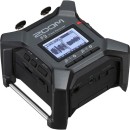
Zoom F3 |
VS | |
|---|---|---|
| Handheld Recorder | Form Factor | Handheld Recorder |
| Audio-for-Video | Primary Use Applications | Audio-for-Video, Dictation & Transcription, Music Recording, Podcasting |
| 2 | Number of Tracks | 8 (6 Inputs + Stereo Mix) |
| 2 | Number of Input Channels | 6 (4 x Mono, 1 x Stereo) |
| 192 kHz / 32-Bit | Maximum Sampling Rate | 96 kHz / 32-Bit Float |
| Microphone | Interchangeable Cardioid Condenser Stereo Pair, X/Y Configuration | |
| 2 | Number of Microphone Inputs | 4 |
| Built-In Speaker | Yes, 500 mW Mono | |
| microSDHC (4 GB to 32 GB) microSDXC (64 GB to 1 TB) |
Memory Card Support | microSDXC (Up to 1 TB) |
| Internal Storage | ||
| Remote Control Capable (Remote Available Separately) | Special Features | Overdubbing |
